7. Documentation Requirements for Cosmetics Notification
In Taiwan, China, the Product Information File (PIF) serves as the core documentation required for cosmetic product notification. It contains detailed information on product composition, safety evaluation, and other critical data, and is a key basis for ensuring that cosmetic products are legally and compliantly placed on the market.
7.1 PIF and Effective Implementation Timeline
The Taiwan Food and Drug Administration (TFDA) under the Ministry of Health and Welfare has released a draft regulation titled “Categories of Cosmetics Required to Establish a Product Information File (PIF) and Their Implementation Dates”, which serves as a comprehensive update and supplement to the 2019 version. According to the draft, effective July 1, 2024, manufacturers and importers of certain functional cosmetics-including sunscreens, hair dyes, hair perms, antiperspirants/deodorants, and at-home tooth whitening products-are required to establish a complete and compliant Product Information File (PIF).
The implementation will be carried out in three phases, with specific timelines and product categories defined for each phase, ensuring a progressive transition toward full compliance.
|
Phase
|
Effective Date
|
Scope of Implementation
|
|
Phase 1
|
From July 1, 2024
|
Cosmetics containing ingredients listed in the annex; or cosmetics intended for antiperspirant/deodorant use or at-home tooth whitening (containing peroxides), even if the ingredients are not listed in the annex but are regulated in the EU or the US.
|
|
Phase 2
|
From July 1, 2025
|
Cosmetics intended for infants, lip products, eye area products, as well as non-medicinal toothpastes and mouthwashes.
|
|
Phase 3
|
From July 1, 2026
|
All other cosmetics not mentioned in the above phases, excluding solid handmade soaps produced in manufacturing sites exempt from factory registration.
|
7.2 Main Contents of the Product Information File (PIF)
According to the Cosmetic Product Information File Management Regulations (No. 1081604087), the PIF should be stored in written or electronic form and retained for at least 5 years from the day following the last market release. The following data should be compiled in Chinese or English:
- Basic Product Data: Product name, category, form, purpose, manufacturer name and address, and information on the manufacturer or importer
- Proof of Product Registration
- Complete Ingredient List and Concentrations
- Product Labels, Leaflets, Outer Packaging, or Containers
- GMP Compliance Documentation
- Manufacturing Method and Process
- Usage Method, Application Area, Dosage, Frequency and Target Demographic
- Adverse Reaction Data
- Physical and Chemical Properties
- Toxicological Data of Ingredients
- Stability Test Report
- Microbial Test Report
- Preservative Efficacy Test Report
- Functionality Assessment Documentation
- Packaging Material Information
- Product Safety Information
7.3 Labelling
According to Taiwan’s Cosmetic Hygiene and Safety Act and the Regulations for Labeling on Outer Packaging, Containers, Labels, or Package Inserts of Cosmetics (Document No.1081603869), the following information must be clearly indicated on cosmetic product labels:
- Product Name: For products with both inner and outer packaging, the Chinese product name must be clearly labeled on the outer packaging. The container must also bear the product name, either in Chinese or a foreign language.
- Intended Use
- Directions for Use and Storage Instructions
- Net Weight, Volume, or Quantity
- Full Ingredient List
- Warnings and Precautions: Specific warnings are required for products such as hair perming, hair dyeing, and bleaching products.
- Name, Address, and Telephone Number of the Manufacturer or Importer; For imported products, the Country of Origin must be indicated. For products manufactured in multiple stages, the country of origin refers to the place where the final product is produced.
- Manufacturing Date and Expiry Date, or Manufacturing Date and Shelf Life, or Expiry Date and Shelf Life: If only the year and month are indicated for the manufacturing date or shelf life, the last day of that month shall be deemed the manufacturing or expiration date.
- Batch Number
- Other items as publicly announced by the competent authority
Labels may be presented in Chinese or other internationally recognized languages; however, the full ingredient names must be indicated in English.
7.4 Factory Requirements-Good Manufacturing Practice (GMP)
On June 28, 2024, the Taiwan Food and Drug Administration (TFDA) officially repealed the regulation titled “Types of Cosmetics Required to Comply with Good Manufacturing Practice Guidelines” and promulgated a new regulation entitled “Types of Cosmetics Manufactured in Facilities Required to Comply with Cosmetic Good Manufacturing Practice (GMP) Guidelines”. The implementation of this regulation will be carried out in three phases:
|
Phase
|
Effective Date
|
Scope of Implementation
|
|
Phase 1
|
From July 1, 2024
|
Cosmetics that contain ingredients listed in the attached schedule; or contain ingredients not listed in the schedule but regulated for use in the European Union, the United States, or Japan, and are intended for functions such as sun protection, hair dyeing, hair perming, antiperspirant/deodorizing, or home-use tooth whitening products containing peroxides.
|
|
Phase 2
|
From July 1, 2025
|
Cosmetics intended for infants, lip products, eye area products, as well as non-medicinal toothpastes and mouthwashes.
|
|
Phase 3
|
From July 1, 2026
|
All other cosmetics not mentioned in the above phases, excluding solid handmade soaps produced in manufacturing sites exempt from factory registration.
|


